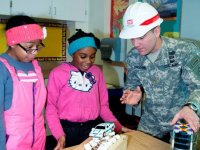Encouraging Science at Home is Easier Than You Think
Your content has been saved!
Go to My Saved Content.I am often asked by parents, "What can we do to get our child interested in science?" My reply is always the same: "Your child is already interested in science!"
Children are explorers, observers and tinkerers. It's why they open up cabinets, roll balls down staircases, and proudly exhibit toads found in the backyard. It's why they love playing with flashlights, making paper airplanes, and mixing up "chemicals" needed to make chocolate brownies.
I have yet to meet a child that does not think like a scientist. Adam Savage of Discovery Channel's MythBusters often reports that a member of his crew had an epiphany: "The difference between play and the scientific method is writing stuff down." Another principle is that exploration should be encouraged.
The Science of Taking Stuff Apart
If you spend time with children, you know that they find as much joy deconstructing something as they do putting things together. This is because dismantling something into component parts helps kids understand how things work.
Owners of outdated personal computer towers might view their PCs as junk, but not an eight-year-old. She sees the opportunity for scientific exploration. Arm your little engineer with a few sizes of Phillips head screwdrivers, and then allow her to dissect memory cards, motherboards, hard drives, circuit boards and cooling fans. Take a nine-volt battery, connect it to the fan wires and watch it spring to life. Such an activity shows your child how everyday items are put together and engineered. It also increases comfort with tools and allows her to see the complexities of technology.
Safety Note: For the most part, dissecting a computer is safe. However, be sure to give your child goggles to wear, cut or remove the power cord, and remove the power supply inside the computer since it may contain capacitors that have stored energy.
Your House Has Guts
Science is everywhere. Just about every modern home or building is a scientific marvel, with most of the cool stuff hidden in the walls -- but not all of it is hidden. Give your child a tour of your home's utilities. Really, try it. Show them the system of pipes, valves, vents and ducts. Ask them what they think it all does.
Remove the tank lid on a toilet. As levers move, valves open and close, and water drains and then fills the tank. Put food coloring or even a little glitter in the tank and watch as it flows into the bowl during flushing. Adults don't view plumbing as science. But to children, especially young children, plumbing is a new hidden world to explore. They will enjoy a new children's book by David Macaulay and Sheila Keenan called Toilet: How it Works.
Welcome to My Laboratory
Sometimes, working like a scientist requires the right tools. Having a home "laboratory" can be a fun way to continuously feed curiosity. Whether you use a dedicated space in the house, a cabinet, or a box of goodies that gets stored away until needed, creating a home laboratory is easier than you think and can cost less that $30 to start.
Visit the pharmacy for vials, eyedroppers, suction bulbs, jumbo syringes, magnifiers and balloons. Pick up safety goggles, funnels, tubing, magnets, disposable gloves, mini flashlights, vinegar, baking soda, food coloring, dish soap, measuring spoons, and plastic mixing and storage containers. And don't forget a good waterproof tablecloth.
Then stand back and let the exploration happen. Will food coloring turn kids' hands green? Probably. Will it get messy? Yes, because science gets messy. But it's all worth it when children wonder, "What will happen if. . .?" -- a critical question that is part of hypothesis testing. Encourage observing, mixing and maybe even recording results, because this is what scientists do.
The 3-Day Zoo
The outdoors provides an ever-changing pallet of discoveries for young explorers. Next time that you walk with children through the woods, take your time and encourage them to turn over logs and rocks to explore what is underneath. When your kids are on critter watch, they’ll find snails, beetles, lizards and frogs. Don't be surprised when they beg to keep them.
Fortunately, there is a way for you to board small critters at your house without acquiring a new pet. Three-day zoo materials include a large plastic tank or container (I like the type that bulk snack foods come in) to create a short-term space for small creatures. Poke a few holes in the lid and place some window screen inside the holes if you are worried about critters going AWOL. The three-day zoo allows children more time to observe an animal's habits and interactions while making sure the critter gets released back into the wild.
Science experiences at or near home needn't demand too much time or effort on the part of adults. A few tools and encouragment can set young ones up for many adventures. Do it for the love of your child, and for the love of science.
Share the scientific adventures that children enjoy at or near your home.
